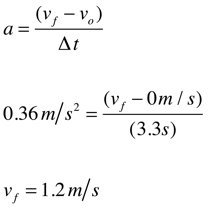Physics Essay 4.2 Spring, 2012
F=m.a
What is the relationship between force and acceleration?
In a recent car-and-ramp lab, you measured the acceleration of a car caused by a range of forces. By plotting force vs. acceleration, drawing a best fit line through the data, and calculating the equation of the line, you were able to find the relationship between force and acceleration: F=ma. A similar graph is shown below.

Figure 1, Data from the force-acceleration experiment is displayed above.



y = mx + b find slope with (y2-y1)
(x2-x1)
F = 1.43a + 0
F = 1.43a (mass of car is 1.43 kg)
F = ma

In this experiment, the mass of the car was independently measured on a balance to be 1.43 kg. The slope of the line on graph was calculated to be 1.43. In the lab we did, most groups had slopes that matched the mass of their car very closely, so we concluded that the slope of the line IS the mass of the car. This gave us the equation F=ma, which is Newton’s 2nd Law and perhaps the most important equation in all of science. It is important to remember that the F in this equation refers to the net force.
Mass is a measure of an object’s inertia. A large mass gives an object lots of inertia and makes it hard to change the object’s motion (hard to speed up and hard to slow down).
Let’s consider a few applications of the 2nd Law.
Example 4.2.1
A fan-boat moves through the Everglades Swamp. The fan places a force of 1200N on the boat. The boat experience an air resistance force that impedes it’s motion of 800N. If the mass of the boat is 839 kg, what is its acceleration?
To solve this problem, we draw a free body diagram (FBD). An FBD shows all the forces acting on the object at a moment in time.
Ff
The force of gravity (Fg) pulls the boat down and the force of the water (Fw) pushes the boat up. These two forces cancel each other out. The force of the fan (Ff) pushes the fan-boat to the right and the force of the air resistance (FAR) pushes on the boat toward the left.
Since the Fg and Fw cancel out, we can calculate the net force on the boat by subtracting the ‘left’ force from the ‘right’ force.




FAR
Fg

Fw

Fnet = Ff - FAR
Fnet = 1200N - 800N
Fnet = 400N to the right
We can then use the net force and the mass to calculate the acceleration of the boat.
Fnet = ma
400N = (839kg)a
400N/839kg = a
a = 0.48 m/s/s
As long as these forces keep pushing in this same exact way, the boat will increase its velocity by 0.48 m/s each second.
Example 4.2.2
Your new mini-Ferrari runs out of gas, and your friends come to help you push it home. Sally pushes to the right with a force of 220N, Ben pushes with a force of 260N to the right, and Glenda pushes to the right with a force of 310N. You arch-enemy, Ruprect, pushes to the left with a force of 420N, trying to prevent your progress. If the mass of the mini-Ferrari is 1021 kg, what is the car’s acceleration?
To solve this problem, we draw a free body diagram (FBD).
FS
The force of gravity pulls the car down (Fg) and the force of the ground (FG) pushes the car up. These two forces cancel each other out. If they did not cancel out, the car would move up off the ground or into the ground! The force of the three friends pushes the car to the right and the force of Ruprect pushes on the car toward the left.
Since the Fg and FG cancel out, we can calculate the net force on the car by subtracting the ‘left’ force from the ‘right’ forces.



FR
Fg

FG

Fnet = FS + FB + FG - FR
Fnet = 220N + 260N + 310N - 420N
Fnet = 470 N
We can then use the net force and the mass of the car to calculate the acceleration of the car.
Fnet = ma
370N = (1021kg)a
370N/1021kg = a
a = 0.36 m/s/s
As long as these forces keep pushing in this same exact way, the car will increase its velocity by 0.36 m/s each second.

FB
FG


After 3.3 seconds of these forces being applied, how fast is the car moving? Assume the car starts from rest.

Example 4.2.3
In the motion sensor and fan-car experiment, you pushed the car to the right to get it started. Let’s think about the time DURING the push, or while your hand was still pushing the car. You are pushing to the right with a force of 43N and the fan pushes to the left with a force of 21N. If the acceleration is 7.2 m/s/s, what is the mass of the car?
To solve this problem, we draw a free body diagram (FBD).
The force of gravity pulls the car down (Fg) and the force of the ground (FG) pushes the car up. These two forces cancel each other out. If they did not cancel each other out, the car would move up off the ground or into the ground!
Since Fg and FG cancel out, we can calculate the net force on the fan-car by subtracting the ‘left’ force from the ‘right’ force.
Fg

FG

Fnet = FHand - Ff
Fnet = 43N - 21N
Fnet = 22N
We can then use the net force and acceleration to calculate the mass of the fan-car.
Fnet = ma
22N = m(7.2 m/s/s)
(22N)/(7.2 m/s/s) = m
m = 3.05 kg
FHand

Ff

Example 4.2.4
Remember the experiment when we dropped tennis balls off the balcony of the Science Building and measured time and distance so we could calculate the acceleration caused by gravity. We concluded that the acceleration caused by gravity, or ‘little g’, was g = 9.8 m/s/s.
We can use this acceleration to calculate the weight of an object. Imagine a person, weighing 55 kg, jumping off a high diving board and falling with no air resistance. They would fall with an acceleration of 9.8 m/s/s. As we discovered in our experiment, all objects fall with an acceleration of 9.8 m/s/s, if they are near the earth and experience no air resistance.
In this case, the only force on the person is their own weight (or the force of gravity on them). This means the net force is equal to the force of gravity.
Fnet = ma
Fnet = Weight (since the only force on the person is their weight)
W = ma (a is equal to little g)
W = mg
W = (55kg)(9.8 m/s/s)
W = 539 N







You can always use the equation W = mg to calculate an object’s weight (g = 9.8 m/s/s, if the object is on or near the earth).












[x1, y1]
[x2, y2]
Copyright © 2009-2012, by Marcus Milling
edited by Julia Pian

Fg

N = kg.m/s2
so.... N/kg is the same
as m/s2



